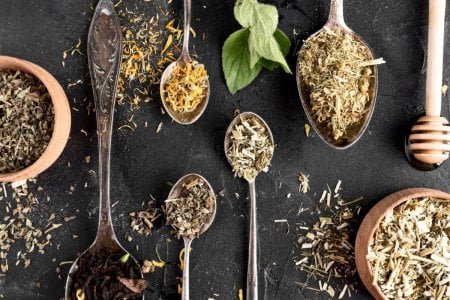Unlock the secret to magnificent meals: When to use fresh vs dried herbs in your cooking
By
VanessaC
- Replies 4
Herbs can take your dishes from basic to bold, but it's important to understand when fresh or dried will work best.
As any serious cook knows, true flavour comes from selecting the right herb in the right form.
Here are some handy guidelines to unlock herb magic in your kitchen:
Most herbs have a tablespoon-to-teaspoon ratio
In general, a tablespoon of fresh herbs is equal to one teaspoon of dried, this means you can substitute one for the other. This is because fresh herbs contain water, which does not contribute flavour or texture but still adds bulk.
For example, if you're cooking something that calls for two tablespoons of fresh, minced basil, you will need two teaspoons of dried basil flakes.
Meanwhile, the same ratio applies when using ground herbs, though it is increased to four parts fresh for every one part ground. So, if your recipe calls for a teaspoon of ground oregano, you must use one tablespoon plus one teaspoon of fresh, minced sage leaves.
A sniff test can tell you whether your herbs are fresh
These guidelines apply when you have freshly bought dried herbs. But if you've had your dried herbs for a while, you'll need to make sure they are still potent before using them in your cooking.
Go ahead and give them a good sniff. If there is a strong aroma, you're good to go! If there is no scent, then it's time to throw them out and start afresh.
If it smells like a faint version of its original self, then it's still okay to use, so long as you can adjust it gradually.
To avoid wasting lesser-potent herbs, one option is to use them as popcorn seasonings.
Mind your sage types
On the topic of seasoning, did you know there are two kinds of sage? There's dried sage, where the leaves (and stems) are dried then ground to a fine powder, and then there's rubbed sage, made by rubbing the dried leaves (note: no stems!) together until they form into fluffy little bits.
Ground sage has a more intense flavour, which is slightly more astringent, pungent, and bitter, plus it has a stronger hint of mint and citrus.
On the other hand, rubbed sage is sweeter, carries a piney flavour with a hint of earthiness, and almost no bitterness.
However, because rubbed sage is fluffier than its ground counterpart, you must double the amount to get the equivalent herbiness. Inversely, if your recipe calls for rubbed sage, but all you have is ground sage, then just use half the amount given in the recipe.
Say no to dried parsley
When it comes to dried herbs, most will do fine in sauces, soups and stews.
The lone exception here is dried parsley, an herb some experts call ‘largely pointless’ herb as it offers only a slight hint of herbiness.
For best results, use fresh herbs as garnish
Finally, when using herbs in raw preparations, for example, in salads or as a garnish, it's always best to avoid dried herbs.
Those desiccated flakes will just feel like paper confetti in your mouth.
To get the most out of your herb flavourings, use fresh ribbons of basil on top of your pizzas, as dried flakes will not do your pies any good.
 Members, do you have any tips when using herbs? Share them with us in the comments below!
Members, do you have any tips when using herbs? Share them with us in the comments below!
As any serious cook knows, true flavour comes from selecting the right herb in the right form.
Here are some handy guidelines to unlock herb magic in your kitchen:
Most herbs have a tablespoon-to-teaspoon ratio
In general, a tablespoon of fresh herbs is equal to one teaspoon of dried, this means you can substitute one for the other. This is because fresh herbs contain water, which does not contribute flavour or texture but still adds bulk.
For example, if you're cooking something that calls for two tablespoons of fresh, minced basil, you will need two teaspoons of dried basil flakes.
Meanwhile, the same ratio applies when using ground herbs, though it is increased to four parts fresh for every one part ground. So, if your recipe calls for a teaspoon of ground oregano, you must use one tablespoon plus one teaspoon of fresh, minced sage leaves.
A sniff test can tell you whether your herbs are fresh
These guidelines apply when you have freshly bought dried herbs. But if you've had your dried herbs for a while, you'll need to make sure they are still potent before using them in your cooking.
Go ahead and give them a good sniff. If there is a strong aroma, you're good to go! If there is no scent, then it's time to throw them out and start afresh.
If it smells like a faint version of its original self, then it's still okay to use, so long as you can adjust it gradually.
To avoid wasting lesser-potent herbs, one option is to use them as popcorn seasonings.
Mind your sage types
On the topic of seasoning, did you know there are two kinds of sage? There's dried sage, where the leaves (and stems) are dried then ground to a fine powder, and then there's rubbed sage, made by rubbing the dried leaves (note: no stems!) together until they form into fluffy little bits.
Ground sage has a more intense flavour, which is slightly more astringent, pungent, and bitter, plus it has a stronger hint of mint and citrus.
On the other hand, rubbed sage is sweeter, carries a piney flavour with a hint of earthiness, and almost no bitterness.
However, because rubbed sage is fluffier than its ground counterpart, you must double the amount to get the equivalent herbiness. Inversely, if your recipe calls for rubbed sage, but all you have is ground sage, then just use half the amount given in the recipe.
Say no to dried parsley
When it comes to dried herbs, most will do fine in sauces, soups and stews.
The lone exception here is dried parsley, an herb some experts call ‘largely pointless’ herb as it offers only a slight hint of herbiness.
For best results, use fresh herbs as garnish
Finally, when using herbs in raw preparations, for example, in salads or as a garnish, it's always best to avoid dried herbs.
Those desiccated flakes will just feel like paper confetti in your mouth.
To get the most out of your herb flavourings, use fresh ribbons of basil on top of your pizzas, as dried flakes will not do your pies any good.
Key Takeaways
- The flavour of fresh herbs and dried herbs vary and one tablespoon of fresh herbs usually equals one teaspoon of dried herbs.
- The freshness of dried herbs can also influence their strength of flavour, with old stock of herbs potentially requiring larger quantities to achieve the same taste.
- The differences between ground and rubbed sage are significant, with ground sage providing an intensely flavoured and slightly more astringent, pungent, and bitter product, and rubbed sage providing a gentler, slightly sweeter flavour.
- Fresh herbs are recommended for use as garnish or for salads due to their texture and flavour, as dried herbs were described to have an unpleasant texture and less desirable flavour in this context.








